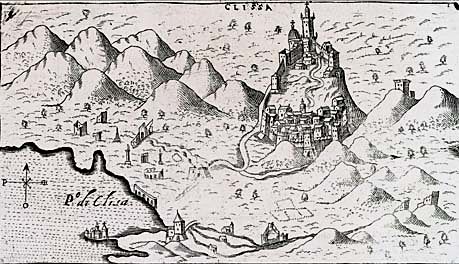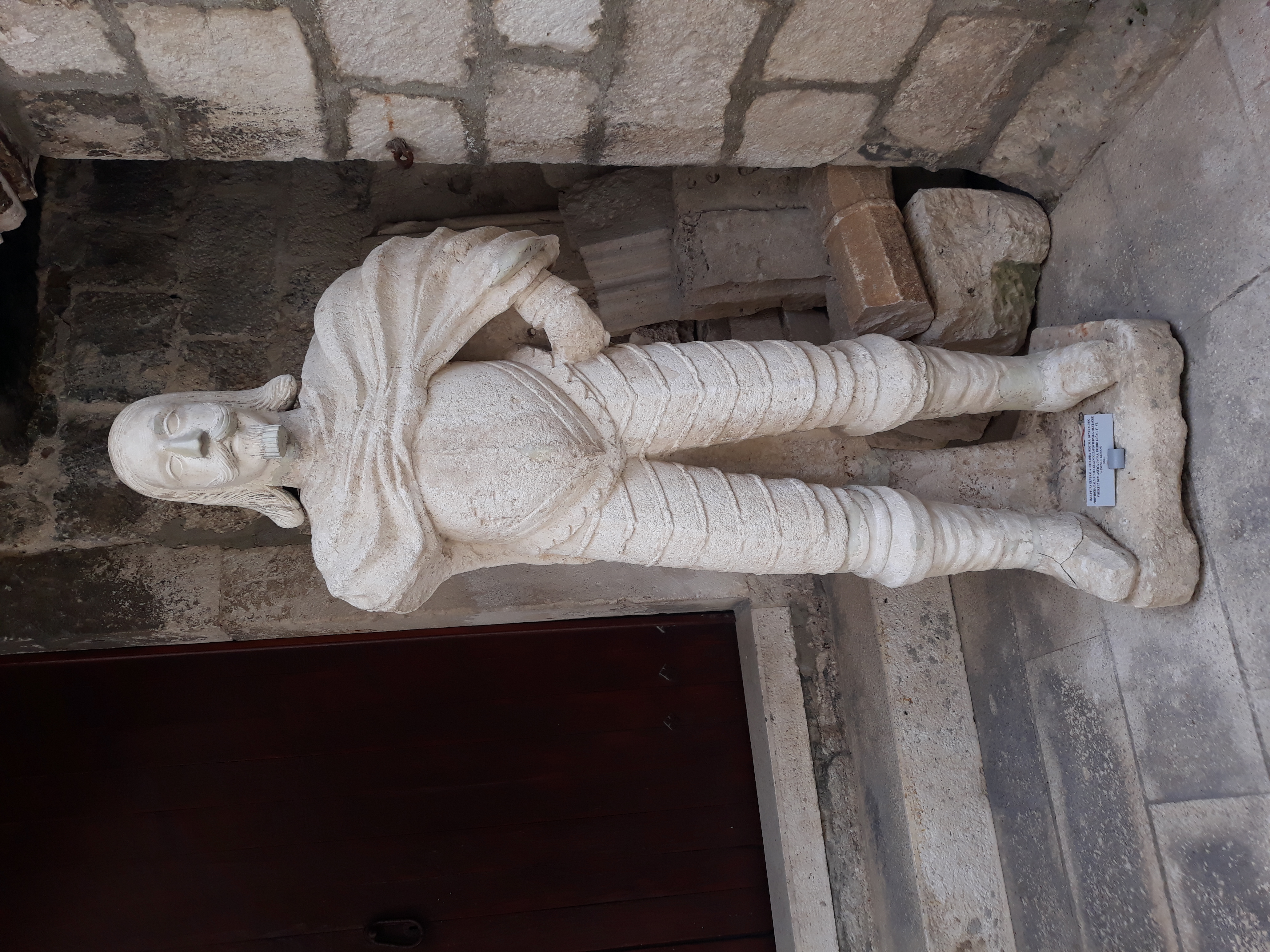|
Smiljanić Family
The Smiljanić family (''Smogianich'') were a Croatian or Vlach family originating from Lika and first mentioned in the 17th century, when the oldest member Petar Smiljanić was a ''harambaša'' and ''capo'' (head) of the Morlach troops in Venetian service during the Cretan War (1645–69), in Venetian Dalmatia. He was born in Udbina, in the Lika region, then moved with his family to Venetian Dalmatia ( Ravni Kotari) in 1647. From the family originated nine serdars, who participated in the Cretan War (1645–69) and Morean War (1684–1699). History It is considered that the family is related to noble officer family Smoljan/Smoglian from Senj, recorded in the mid-16th century and serving military positions in the military units of Lika and Gacka. Petar Smiljanić was titled as ''capo (principale)'', and after arrival was included in the troops of commander Bosichi Renesi, and was noted for orderly holding his horse and weapons. Already in first battles with Ottoman forces, he b ... [...More Info...] [...Related Items...] OR: [Wikipedia] [Google] [Baidu] |
Smiljanić 2
Smiljanić ( sr-cyr, Смиљанић) is a surname found in Serbia and Croatia, derived from the given names Smilja (feminine) or Smiljan (masculine). Notable people with the name include: * Smiljanić family, a medieval family in Venetian Dalmatia * Aleksandra Smiljanić, Serbian professor * Branko Smiljanić, Serbian football manager * Boris Smiljanić, Swiss footballer of Croatian descent * Božidar Smiljanić (1936–2018), Yugoslav and Croatian actor * Goran Smiljanić, Serbian footballer * Mićo Smiljanić, Serbian footballer * Milan Smiljanić, Serbian footballer * Vladana Likar-Smiljanic, Serbian illustrator * Živorad Smiljanić, Serbian politician See also *Miljanić Miljanić is a South Slavic surname. Notable people with the name include: * Ana Miljanić (born 1982), Serbian athlete and politician * Dijana Miljanić (born 1997), Montenegrin football player * Miljan Miljanić (1930–2012), Yugoslav and Se ... {{DEFAULTSORT:Smiljanic Surnames of Serbian or ... [...More Info...] [...Related Items...] OR: [Wikipedia] [Google] [Baidu] |
Novigrad, Zadar County
Novigrad is a village and municipality in Croatia in the Zadar County. According to the 2011 census, there were 2,375 inhabitants, absolute majority of which were Croats. History In 1386, the Hungarian and Croatian sovereign Mary and her mother, Elizabeth of Bosnia, were imprisoned in Novigrad. Elizabeth was strangled in Novigrad in 1387 but Mary was liberated. It was part of Republic of Venice in 1409. Venetian rule in Novigrad briefly interrupted by Ottoman occupation between 1646 and 1647 during Cretan War. Attractions The historic little town on the southern side of the Novigrad sea is situated in a narrow bay. The Novigrad sea is abundant in fish and shellfish, which is why Novigrad fishermen are well known. The town has preserved its Mediterranean The Mediterranean Sea is a sea connected to the Atlantic Ocean, surrounded by the Mediterranean Basin and almost completely enclosed by land: on the north by Western Europe, Western and Southern Europe and Anatolia, on th ... [...More Info...] [...Related Items...] OR: [Wikipedia] [Google] [Baidu] |
Korlati
Korlati ( sr-cyrl, Корлати) is a village in the municipality of Trebinje, Republika Srpska, Bosnia and Herzegovina Bosnia and Herzegovina ( sh, / , ), abbreviated BiH () or B&H, sometimes called Bosnia–Herzegovina and often known informally as Bosnia, is a country at the crossroads of south and southeast Europe, located in the Balkans. Bosnia and H ....Official results from the book: Ethnic composition of Bosnia-Herzegovina population, by municipalities and settlements, 1991. census, Zavod za statistiku Bosne i Hercegovine - Bilten no.234, Sarajevo 1991. References Villages in Republika Srpska Populated places in Trebinje {{Trebinje-geo-stub ... [...More Info...] [...Related Items...] OR: [Wikipedia] [Google] [Baidu] |
Vuk Mandušić
Vuk Mandušić ( sr-Cyrl, Вук Мандушић; Vučen Mandušić, ''Vucen Mandussich''; 1645 – died 13 July 1648) was the ''capo direttore'' of the Morlach army, one of the most prominent '' harambaša'' (rebel leaders) in the Dalmatian hinterland, that fought the Ottoman Empire during the Cretan War (1645–69). He is one of the heroes renowned in Serbian epic poetry. The Serbian poet-prince-bishop Petar II Petrović Njegoš from Montenegro immortalized him in one of his epic poems, ''Gorski vjenac'', also known in English translation as '' Mountain Wreath''. Early and personal life Mandušić was a leader of '' Morlach'' or ''Vlach'' army, which is how Venice referenced Serbs. His birthplace is undetermined, but it is generally considered he was born somewhere in the Dalmatian Zagora. Several localities in the hinterland of modern-day Šibenik-Knin County has been given: most commonly Rupe near Skradin, according to the oral tradition preserved in the work from 175 ... [...More Info...] [...Related Items...] OR: [Wikipedia] [Google] [Baidu] |
Uskoks
The Uskoks ( hr, Uskoci, , singular: ; notes on naming) were irregular soldiers in Habsburg Croatia that inhabited areas on the eastern Adriatic coast and surrounding territories during the Ottoman wars in Europe. Bands of Uskoks fought a guerrilla war against the Ottomans, and they formed small units and rowed swift boats. Since the uskoks were checked on land and were rarely paid their annual subsidy, they resorted to acts of piracy. The exploits of the Uskoks contributed to a renewal of war between Venice and the Ottoman Empire (1571–1573). An extremely curious picture of contemporary manners is presented by the Venetian agents, whose reports on this war resemble a knightly chronicle of the Middle Ages. These chronicles contain information pertaining to single combats, tournaments and other chivalrous adventures. Many of these troops served abroad. After a series of incidents that escalated into the Uskok War (1615–1618), the Uskok activity in their stronghold of Sen ... [...More Info...] [...Related Items...] OR: [Wikipedia] [Google] [Baidu] |
Janko Mitrović
Janko Mitrović ( sr-cyr, Јанко Митровић; 1613–1659) was a ''harambaša'' (Ottoman for "bandit leader"), and the commander of the '' Morlach army'', in the service of the Republic of Venice, from 1648 until his death in 1659. He participated in the Cretan War (1645–69), alongside Ilija Smiljanić, as the supreme commanders of the Venetian Morlach troops, of which he is enumerated in Serb epic poetry (as Janko of Kotari, Јанко од Котара). His son, Stojan Janković, followed in his father's footsteps. Life Janko was the son of Mitar (born c. 1585), whose family hailed from village Zelengrad or Žegar in the area of Bukovica. Janko had brothers Jovan, Stjepan, Pavle, and Andrija, and probably was among the youngest brothers. Vukadin Mitrović was also a ''harambaša'' in Venetian service, possibly another brother, or a cousin. Mitrović in 1646 was recorded as a defender of Šibenik, and in 1649 was rewarded with a monthly payment of 4 ducats. Stojan, ... [...More Info...] [...Related Items...] OR: [Wikipedia] [Google] [Baidu] |
Provveditore
The Italian title ''prov ditore'' (plural ''provveditori''; also known in gr, προνοητής, προβλεπτής; sh, providur), "he who sees to things" (overseer), was the style of various (but not all) local district governors in the extensive, mainly maritime empire of the Republic of Venice. Like many political appointments, it was often held by noblemen as a stage in their career, usually for a few years. Adriatic home territory *In the Stato di Terraferma, the continental part of northern Italy acquired by Venice, mainly in the 15th century, they were appointed in considerable number as part of a complex hierarchical structure, including territories (the upper level), '' podesterias, capitanatos, vicariatos'', ecclesiastical and private jurisdictions etc. Overseas territories (Stato da Mar) Some were Venetian possessions much earlier, but no data on the style of their governors exist; most were lost to the Ottoman Empire. Eastern Adriatic *On the Istria peninsula, ... [...More Info...] [...Related Items...] OR: [Wikipedia] [Google] [Baidu] |
Gusić Family
The Gusić family, also known as Gušić, was one of the twelve noble tribes of the Kingdom of Croatia, mentioned in the Pacta conventa. They originated from the hinterland of Biograd in the medieval Luka and Sidraga županijas, where they are recorded at least since the 11th century. Their main regions of influence were Krbava and Gacka, where they often served as župans and knezes at least since the early 13th century. In the 14th century branched Posedarski who seated in Posedarje, and Kurjakovići who as magnates managed to gather much wealth and have high official positions at the Hungarian royal court as well two of their members became Ban of Croatia. As experienced warriors, they actively participated in the Croatian–Ottoman and late Ottoman–Venetian Wars. Direct descendants of the tribe with the surname Gusić, and possibly Gušić, live even today in Croatia and Slovenia. Etymology The family name ''Gus''(''-ić'') most probably derives from the Slavic '' ... [...More Info...] [...Related Items...] OR: [Wikipedia] [Google] [Baidu] |
Leonardo Foscolo
Leonardo Foscolo (1588. - 1660.) was a Venetian commander. During the Cretan War (1645–1669), Leonardo Foscolo seized several forts, retook Novigrad, temporarily captured the Knin Fortress, and managed to compel the garrison of Klis Fortress ) from Vrana, in the name of Bosnian King Tvrtko I * 1394–1401 Ban Nikola II Gorjanski in the name of Sigismund * 1401–1434 Croatian noble Prince Ivaniš Nelipić * 1434–1436 Croatian noble and Ban of Croatia Ivan Frankopan, at that ... to surrender.Fraser (1854), pp. 244–245.Setton (1991), pp. 148–149. Footnotes Bibliography * * Federico Moro - Venezia e la guerra in Dalmazia (1644-1649) - Anno edizione: 2018 - Republic of Venice people of the Ottoman–Venetian Wars 17th-century Italian military personnel {{Italy-mil-bio-stub ... [...More Info...] [...Related Items...] OR: [Wikipedia] [Google] [Baidu] |
Unac (river)
The Unac ( sr-cyrl, Унац) is a sinking river in Bosnia and Herzegovina. It rises beneath Šator mountain, flows through the municipality of Drvar and finally meets Una River in Martin Brod. Also runs through two deep and rugged karstic canyons and it is dammed to form small Preodačko Lake and larger Župica Lake, before it reach town of Drvar. Lower course of the Unac River and its canyon is included into the Una National Park. Fluss Unac in der Schlucht vor Martin Brod.JPG, Unac leaving a canyon at Martin Brod outskirts. Unac, 400 m before confluence with Una at Martin Brod.JPG, Flyfishing on the Unac at the outskirts of Martin Brod. See also *Sinking river A losing stream, disappearing stream, influent stream or sinking river is a stream or river that loses water as it flows downstream. The water infiltrates into the ground recharging the local groundwater, because the water table is below the bo ... References External links Rivers of Bosnia and Herz ... [...More Info...] [...Related Items...] OR: [Wikipedia] [Google] [Baidu] |
Turkish Croatia
Turkish Croatia (german: Türkisch Croatien/Kroatien, hr, Turska Hrvatska) was a geopolitical term which appeared periodically during the Ottoman–Habsburg wars between the late 16th to late 18th century. Invented by Austrian military cartographers, it referred to a border area of Bosnia located across the Ottoman-Austrian border from the Croatian Military Frontier. It went out of use with the Austro-Hungarian rule in Bosnia and Herzegovina. Location The name was used on the region of Bosanska Krajina (''Krajina'' = en, Military Frontier, Military frontier; in Medieval Bosnia it was known as ''Donji Kraji'' ( en, Lower Ends) and ''Zapadne Strane'' ( en, Westward Sides)). This territory was usually depicted as roughly comprising the land area between the river Vrbas River, Vrbas in the east, the Sava in the northeast, the Una (Sava), Una in the northwest, as well as Dinara mountain in the south, including the ''Cazin, Cazinska krajina'' pocket in the far west. Parts of Lika, Bano ... [...More Info...] [...Related Items...] OR: [Wikipedia] [Google] [Baidu] |
_dvor.jpg)

